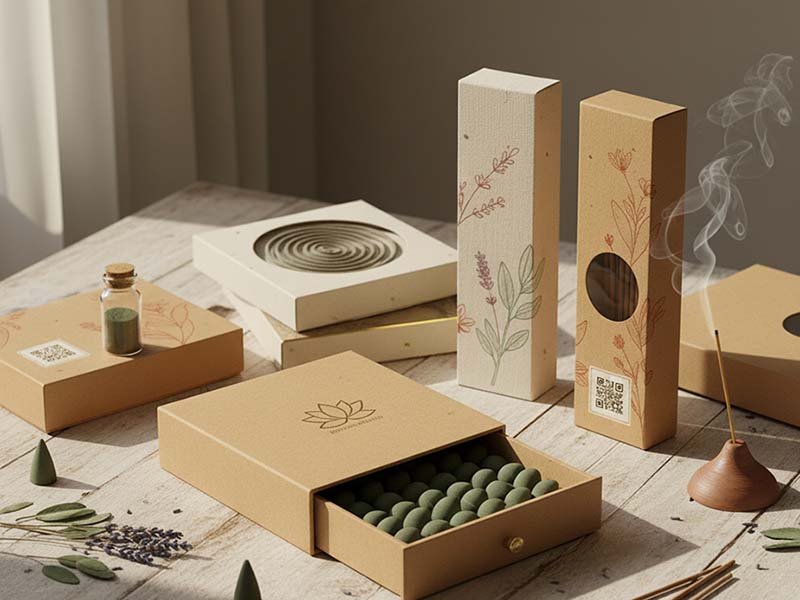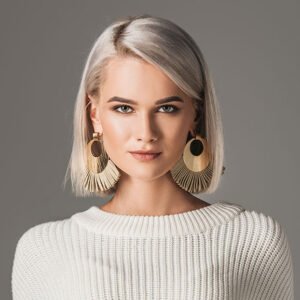
In an age where the sense of smell is more accessible—but competition is fiercer—how you package incense can make or break the impression. Incense isn’t just a product—it’s an experience. The box isn’t just a container; it’s your brand’s first “inhale.” That’s why incense boxes, custom incense packaging, incense stick boxes, and incense cones packaging are no longer afterthoughts—they’re essential storytelling tools.
Why Great Incense Packaging Matters
Before we get to how to design or produce these, here are key reasons why good packaging is critical:
| Benefit | What It Means for Your Brand |
|---|---|
| First impression | Beautiful incense boxes attract attention in a shop or online thumbnail. It helps you stand out from mass-market competition. |
| Protection | Incense sticks and cones are fragile—moisture, breakage, rubbing can ruin them. Proper packaging preserves scent, integrity, and shape. |
| Brand story & value | Custom incense boxes let you tell your story: where the incense comes from, what materials you use, your values (e.g. sustainability, artisanal). |
| Pricing & positioning | A premium, well-designed custom packaging signals higher perceived value; simpler boxes communicate affordability. |
| Sustainability & consumer choice | Many consumers now expect packaging that is eco-friendly. Using recyclable, compostable, or minimal materials can be a strong positive. |
What’s New in Incense Packaging for 2025
Trends for incense stick boxes, incense cones packaging, and the broader category of custom incense boxes are shifting.
Here are some of the key design & material trends:
1.Sustainability is core, not optional
- FSC-certifiedkraft or recycled boards.
- Compostable or aqueous coatings instead of plastic laminates.
2.Earthy & neutral color palettes with occasional metallic accent
- Colors like sage, terracotta, and almond are popular.
- Use of gold or silver foiling, metallic inks in small doses for premium feel.
3.Textures & tactile finishes
- Embossing, debossing, soft-touch finishes, linen stock or handicraft paper surfaces.
4.Minimalism, yet expressive
- Clean, simple designs with restrained typography and subtle motifs.
- But minimal doesn’t mean plain: artistic illustrations, spiritual symbols, or cut-outs are being used.
5.Interactive / experiential elements
- QR codes linking to rituals, meditation guides, playlists.
- Windowsor cut-outs that reveal a peek of the incense inside.
6.Versatility & reusability in boxes
- Drawer-style boxes or sleeves that double as storage.
- Durable rigid packagingused for gift sets, cones, or combined incense + holder sets.
Types of Packaging by Incense Form
Not all incense is the same—sticks, cones, coils, powder/dhoop—and each type benefits from different packaging structures. Here’s a breakdown:
| Incense Form | Common Packaging Type | Important Characteristics |
|---|---|---|
| Sticks | Tuck-end boxes, sleeve boxes, drawer/slip boxes | Length matters; avoid bending. Include moisture protection. Visual cues of scent via color or imagery work well. |
| Cones | Rigid boxes, small drawer boxes, boxes with inserts | Cones are fragile; inserts help. Also, packaging that prevents crushed tips. Display-friendly if you show cones inside. |
| Coils / Spirals | Flat boxes with separators or trays/inserts | Prevent coils from uncoiling; protect edges. Visibility might help but balance with protection. |
| Dhoop / Powder | Tubes, jars, or tuck-top boxes with inner liner | Protection from moisture. Consider resealable or secure closure. |
What Makes Custom Incense Boxes Special
“Custom incense packaging” is a phrase that covers many possibilities. Here are features that distinguish the ordinary from standout:
- Material variety: kraft, SBS / premium paperboard, rigid boards, linen finishes, scented papers, or even wood or bamboo overlays.
- Printing & finishing options: full-color prints, metallic foils, embossing / debossing, spot UV / gloss / matte coatings.
- Structural design & unique shapes: tuck-end, sleeve, slide drawers, boxes with window cut-outs, custom die-cuts.
- Add-ons: inserts, trays, aroma-lock linings, explanatory cards, dual-use boxes.
Case Study: Crafting the Perfect Incense Box
Let’s run through a hypothetical brand (“AuraScents”) launching a line of natural incense sticks and cones. How would they plan their packaging?
1.Define product forms
- Two types: 20-stick box + box of 12 incense cones.
2.Target audience & values
- Health/wellness-oriented, cares about natural ingredients, sustainability, and aesthetics (Instagram-friendly).
3.Material choice
- Use recycled kraft board for primary material.
- Use soy-based inks.
- No plastic wrap; if a window is needed, use compostable film.
4.Design features
- Minimalist art: botanical illustrations of herbs used (e.g. lavender, sage).
- Earthy color palette: sage green, muted brown, soft cream. Accent with subtle gold foil for logo only.
- For the cones, maybe a rigid drawer box with an insert to separate and protect tips.
5.Finishing touches
- Matte finishes to feel natural. Soft touch surface for a premium tactile sensation.
- Embossed logo to add subtle luxury.
- QR code on back linking to ritual or instructions (how to burn safely, how to pair scents, meditation playlist).
6.Retail / display considerations
- Sizes that match shelf / display units; maybe later a display box to hold multiple flavors.
- Clear labeling of scent, burn time, ingredient origin.
- Consider packaging consistency across sticks & cones line for brand cohesion.
7.Cost & minimums
- Start small: low MOQ packagingsupplier (some custom incense boxes suppliers allow small runs).
- Balance cost vs. premium materials: highest spend on what the consumer perceives immediately (finish, look & feel).
Practical Tips & “Do’s and Don’ts”
Here are actionable tips:
Do’s
- Use mock-ups early to see how design feels in 3D.
- Keep a buffer size in dimensions: protect against swelling/warping from humidity.
- Label clearly: ingredients, scent, burn time, safety warnings.
- Get samples: sometimes materials look different in real life than digital proofs.
- Optimize packaging structure: easy to open, protects the product, minimal waste.
Don’ts
- Don’t overdo graphics: too much visual clutter dilutes brand message.
- Avoid thrift materials that can compromise scent (plastics that trap moisture, inks with strong odors).
- Don’t ignore the cost of finishing—foils, embossing, special coatings add to cost and time.
- Avoid generic boxes: they might ship cheap but may reduce perceived value.
The Market & Consumer Insights
While there isn’t a ton of academic research specifically on incense packaging, broader packaging and fragrance / sensory product studies suggest:
- Consumers associate premium packaging with better quality and are willing to pay more.
- Sustainable, “green” packagingboosts purchase intent, especially among younger demographics.
- Unboxing experience and tactile elements (texture, finish) influence emotional responseto a product.
One useful source from packaging providers noted that consumer demand for eco-materials and minimalist designs.
Examples & Inspiration
Here are some inspiring examples:
- Phool Incense Sticks and Cones– packaging made from recycled temple flowers; creative botanical art and strong visual identity.
- Designs with die-cut windows that subtly show the incense inside.
- Drawer-style or rigid gift boxes that can be repurposed by the user.
Summary: How to Stand Out
If you want your incense brand to shine:
- Start with materials & structure that protect your incense form (sticks, cones, etc.).
- Use finishes and textures to evoke your scent / brand identity.
- Make packaging sustainable where possible—it’s no longer niche.
- Keep design coherent across product lines (sticks, cones, gift sets).
- Consider interactive or experiential touches (QR codes, peek windows, reusable boxes).
Your Next Steps
If you’re developing incense packaging right now, here’s a checklist:
- Define your incense types (sticks, cones, etc.) & quantities per box
- Choose materials (kraft, rigid, eco linings, inks)
- Decide box style (tuck-end, sleeve, drawer, rigid, tubes)
- Finalize design: colors, typography, illustrations, branding
- Pick finishing touches (foils, embossing, window cut-outs)
- Ask for mockups / physical samples
- Ensure packaging logistics (size for shipping, shelf display, cost)
Frequently Asked Questions (FAQs)
Here are answers to questions incense makers or small businesses often have.
What’s the best material for incense cones packaging if I want premium but also eco-friendly?
Rigid paperboard using recycled content or kraft paper, with compostable inner lining or paper insert. Avoid plastic. Use eco-ink. Recycled kraft helps both in appearance and sustainability.
What box style works best for incense sticks?
Tuck-end or sleeve boxes are common, especially for sticks. Drawer/slip boxes are premium and great for gifting. The key is matching length and protecting the stick ends.
How many ounces / sticks per box is typical?
It varies. For example, one company says a 100-gram incense box holds ~70 sticks; a 250-gram box holds ~135 sticks.
How do I ensure packaging preserves scent and prevents damage?
Use tight seals, inserts for cones/coils, avoid moisture-absorbing packaging. Possibly lining boxes with aroma safe inner liners. Choose materials that don’t impart odor. Store in a dry environment.
What’s a reasonable MOQ (minimum order quantity) if I’m starting small?
Some custom incense box manufacturers offer low MOQs (e.g. 50 units) for basic styles. Premium finishes and highly custom shapes may require larger minimums.


